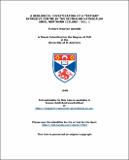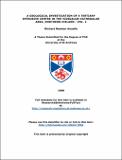Files in this item
A geological investigation of a tertiary intrusive centre in the Vididalur-Vatnsdalur area, Northern Iceland
Item metadata
| dc.contributor.advisor | Dawson, J. B. | |
| dc.contributor.author | Annells, R. N. | |
| dc.coverage.spatial | 3 v. (344, 395) p. | en_US |
| dc.date.accessioned | 2015-07-31T15:40:10Z | |
| dc.date.available | 2015-07-31T15:40:10Z | |
| dc.date.issued | 1968 | |
| dc.identifier | uk.bl.ethos.580323 | |
| dc.identifier.uri | https://hdl.handle.net/10023/7094 | |
| dc.description.abstract | This thesis is an account of an investigation into the structure, petrology and mineralogy of a small Tertiary intrusive centre in the Vididalur-Vatnsdalur area near the north coast of Iceland. The area concerned lies in the Tertiary area west of the neovolcanic zone. In upper Tertiary times the extrusion of flood basalts in the area studied was locally interrupted by the building of a central volcano characterized by distinctive basalts, andesites and pyroclastics, some of which interfingered with contemporaneously extruded flood basalts. The first episode of this central volcanic activity, of which only the top is seen in the area studied, was subsequently buried by the transgressing flood basalts, and slow downsagging occurred in parts of the area along the prevailing north to north-northeast fracture system. A second central volcanic episode produced basalt, andesite and rhyolite extrusions and some pyroclastics in the northeastern part of the area following the flood transgression. Injection of thin basic dykes proceeded parallel to the two phases of central activity and continued during a final episode in which thin pale grey basalts similar to the Lower Pleistocene to Recent flows elsewhere in Iceland were extruded on to the irregular central volcano land surface. Two phases of intrusive activity proceeded parallel to the extrusive activity, the older More deeply eroded First Phase products being emplaced in the time interval during which the older flood basalts buried the newly extruded earlier central volcano lavas. A consecutive Second Phase of intrusive activity proceeded simultaneously with the second central volcanic episode and its less deeply eroded products show many similarities to the contemporaneous extrusions. These First and Second Phase intrusions are probably the upper apophyses of larger bodies concealed at depth. The intrusions which form the main part of the study are concentrated about an intrusive/extrusive centre in northern Vididalsfjall, and consist of coarse- and fine-grained basic to acid series, ranging in the First Phase from olivineeucrites (bytownite cumulates) through gabbros (labradorite cumulates), hybrid diorite and intermediate-acid hybrid types to acid granophyres. The First Phase was initiated by the intrusion of the eucrites and a dense swarm of tholeiitic cone-sheets centred on a focus about 5 km below northern Vididalsfjall. Commingling of the simultaneously available diorite and granophyre magma later in the First Phase resulted in the formation of small volumes of acid-intermediate hybrid rocks. The Second Phase intrusive activity is expressed as small high-level intrusions and began with a new supply of olivinetholeiite magmas which was injected along cone-fractures to form a late set of high-level cone-sheets centred on a focus about 2 km below northern Vididalsfjall. Cogenetic bytownite cumulates were emplaced as small high-level intrusions, but coarse-grained rocks and acid rocks of Second Phase age are rare in the area studied. iii. A broad aureole of hydrothermally altered rocks surrounds northern Vididalsfjall and smaller alteration zones surround other smaller regions cut by vents and intrusions; these altered and injected zones are taken to represent the eruptive channels at the core of the Vididalur-Vatnsdalur volcano. The intrusive rocks are all plagioclase-pyroxene-ore assemblages with or without olivine, alkali feldspar and quartz, and the First Phase types show a gradation from basic rocks bearing calcic plagioclase and magnesian augite to acid rocks containing sodic plagioclase anorthoclase and ferrian augite. The Second Phase rocks show broad petrographic similarity to those of the First Phase but coarse-grained intermediate and acid types are not found, and the basic rocks are richer in olivine than corresponding First Phase types. All the rocks examined show textural and mineralogical evidence of a high degree of fractionation and rapid final cooling at high crustal levels; the plagioclase of phenocryst rims and groundmasses is in a high-temperature structural state, the calcium-rich pyroxenes have immature exsolution textures, the olivines are strongly zoned and interstitial glassy or salic material is abundant. Many of the acid minor intrusions contain tridynlite paramorphed by quartz. Chemical analyses of 14 Vididalur-Vatnsdalur rocks show that they are low in alumina, combined alkalis and magnesia, and are relatively rich in iron, and titania, as are other Tertiary Icelandic tholeiites, with soda present in greater quantity than potash. The analyses of these basic intermediate and acid rocks fit on the iron-enriched trend for tholeiites (Nockolds a.nd AlIen, 1956) which suggests that the First and Second Phase sequences may have originated by -contiriuous fractionation of basic tholeiitic uuterinl. However there is little direct evidence of a tholeiite fractionation origin for the First Phase granitic acid rocks, and the presence of a few small veins of remelted acid material at some localities casts doubt on a fractionation origin for these granophyres and granites of the Vididalur-Vatnsdalur area. | en_US |
| dc.language.iso | en | en_US |
| dc.publisher | University of St Andrews | |
| dc.subject.lcc | QE279.A6 | |
| dc.subject.lcc | QE279.A6 | |
| dc.title | A geological investigation of a tertiary intrusive centre in the Vididalur-Vatnsdalur area, Northern Iceland | en_US |
| dc.type | Thesis | en_US |
| dc.type.qualificationlevel | Doctoral | en_US |
| dc.type.qualificationname | PhD Doctor of Philosophy | en_US |
| dc.publisher.institution | The University of St Andrews | en_US |
This item appears in the following Collection(s)
Items in the St Andrews Research Repository are protected by copyright, with all rights reserved, unless otherwise indicated.


